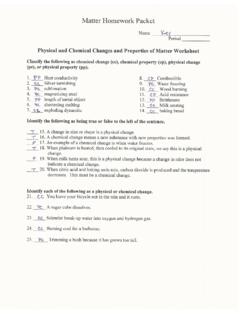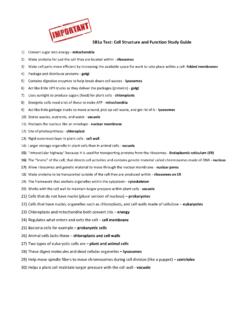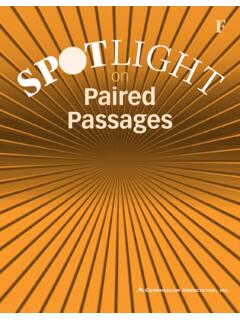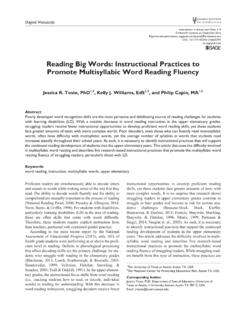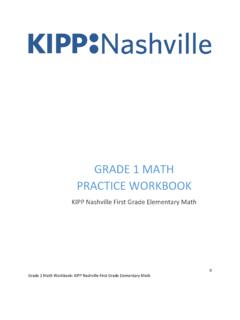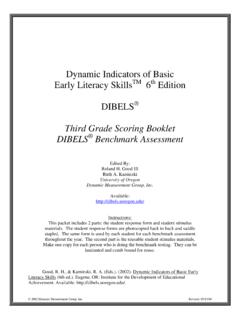Transcription of 3rd Grade Skills - Thomas County School District
1 READING FLUENCY Reading fluency is a very important part of your child s educational learning process. In order for your child to be able to understand what he/she reads, your child needs to be able to read fluently (at a quick pace). Reading quickly in itself will not make your child a better reader, but if your child reads too slowly, all understanding is lost because the child is spending all of his/her time trying to call out the words. Students entering third Grade should be able to read at least 77 words per minute to be considered on Grade level when they begin third Grade . The following two passages are examples of what your child will be expected to read in third Grade . Please let your child practice reading these passages several times each, and then time your child for one minute to see how many words he/she can read correctly in one minute.
2 READING COMPREHENSION Along with reading fluency, students need to understand what they read. In third Grade , students are expected to achieve mastery of all Reading Skills by scoring a 70% or higher for each skill. An EXTREMELY important tool that you can encourage your child to use is to go back into the story after it has been read and underline where your child finds the answer. By asking him/her to do this, you can ensure that your child is actually reading the story. The following stories are examples of what your child will see next year in third Grade . Have your child read each story, underline where they found the answers, and answer each question. Fishing Fun "Beep! Beep! Beep!" roared the alarm clock.
3 Juanita turned the alarm off and looked at the clock. She closed her eyes and wondered why she had to wake up at 4:00 to go fishing. "Juanita! Wake up!" Juanita rolled out of bed quickly and got dressed. As she and Uncle Jack walked out the door, Juanita's mom handed her two bags. "One is for breakfast, the other is for lunch," she said and kissed her on the cheek. In the truck Juanita asked Uncle Jack a million questions. "What kind of fish will we catch? When will we be at the lake? What will we use to catch the fish?" Because it was Juanita's first fishing trip, Uncle Jack calmly answered each question. Finally, they arrived at Lake West Point and put on their lifejackets. As they got in the boat, Uncle Jack gave Juanita her first fishing job untying the boat from the dock.
4 She put one foot up on the edge of the boat. Plop! Into the water went one of the bags. "Oh no! Our lunch is gone!" Juanita cried. But she soon forgot about the lost lunch. Uncle Jack found the perfect fishing spot. He showed Juanita how to bait the hook and throw the line into the water. Faster than you can say "catfish," Uncle Jack caught a fish. "You will get your turn," said Uncle Jack. A strong wind began to blow. "Uncle Jack, do you think it is going " Juanita's question was interrupted by a tug on her line. She had caught a fish! She could not wait to compare her fish to Uncle Jack's fish. Imagine her surprise when her hard work only brought up plants from the lake! "Fishing is fun," Uncle Jack said with a wink of his eye.
5 Before Juanita could answer, the sky opened and hard rain fell. "So, Uncle Jack," Juanita asked, "is fishing always this much fun?" Uncle Jack laughed as he handed Juanita a raincoat. 1) Which statement is probably true about how people all over the world catch fish? a) They use the same type of fishing bait as Juanita. b) They stop fishing when it starts to rain. c) They get up at the same time to catch fish. d) They use some type of pole or tool to catch fish. 2) What is the meaning of the prefix in the underlined word? untying the boat from the dock a) opposite of b) again c) after d) for 3) What did Juanita's mom do that showed she cared for her daughter? a) She gave her food for breakfast and lunch.
6 B) She reminded her to wear a lifejacket. c) She made sure she had a raincoat. d) She gave her a fishing pole to use. How Animals Talk All living things send messages. People talk face-to-face, write letters, and make phone calls. They also use "body talk," like smiling to say, "I am pleased," or shivering to say, "I am cold." Animals send messages to each other too. They make sounds, leave smells, and act in special ways. By doing these things animals warn of danger, set rules for leadership, and tell other animals they have found food. For example, when a male deer rubs against trees to leave his smell, he tells other deer to stay out of his space. White-tailed deer flick their tails up in the air as if to say, "Run!
7 " so other deer can escape danger. Swallowtail caterpillars give off a stinky smell to keep enemies away. Young owls peck at the adults to ask for food. Bull elk crash their antlers together to see who is boss. Even underwater living things send messages. Manatees touch whiskers, chirp, and squeak to say hello. Messages, sent by people or animals, help living things survive, grow, and talk with each other. 4) Why does a swallowtail caterpillar give off a stinky smell? a) to ask for food b) to leave his scent c) to keep enemies away d) to see who is boss 5) Which three words from the passage name things animals do to send messages? a) peck, squeak, rub b) danger, smell, touch c) owls, caterpillars, elk d) smiling, whiskers, warn 6) What kind of passage is How Animals Talk?
8 A) fiction b) poetry c) drama d) nonfiction 7) What might a manatee do to escape danger? a) flick its tail in the air b) touch whiskers with its enemy c) make a chirping sound d) rub its smell against a tree 8) How does the message a white tailed deer sends help the other deer survive? a) It helps them make new friends. b) It tells them where to find food. c) It tells them to stay out of its space. d) It warns them to run from danger. 9) Which homework assignment might the passage help you with? a) List five ways animals escape danger. b) List five animals and tell where they live. c) List four ways animals send messages to each other. d) List four sounds people make when they send messages. 10) Which is a way that real animals talk?
9 A) by writing stories b) by sending e-mails c) by drawing pictures d) by using their bodies State Fair Food Menu Susan and Thomas were spending the day at the State Fair. Around 12:30 , they began to get hungry. They decided to have some lunch. Below is the menu from the fair where they were going to get something to eat. 11) Which of these can Susan buy at the fair? a) potato chips b) fresh fruit c) soup d) pizza 12) What do the marks ** after the heading Sandwiches mean? a) The sandwiches are: Hot Dog, Hamburger, Corndog, and Grilled Cheese b) All sandwiches come with slices of pickles, onions, and tomatoes. c) All sandwiches come with French Fries, a drink, and a dessert. d) The sandwiches range in price from $ to $ 13) Which sentence tells you why Susan and Thomas would want to read the menu?
10 A) Below is the menu from the fair. b) Around 12:30 , they began to get hungry. c) Susan and Thomas were spending the day at the fair. d) All sandwiches come with slices of pickles, onions, and tomatoes. 14) What can you conclude after reading the State Fair Food Menu? a) Susan and Thomas are best friends. b) Susan and Thomas like the food at the fair. c) Susan and Thomas had to be home before 9:00 d) Susan and Thomas arrived at the fair before 12:30 15) Thomas bought four items. It is very hot outside. What item should Thomas eat FIRST? a) french fries b) ice cream c) hot dog d) ice tea 16) Which item from the menu includes tomatoes? a) coleslaw b) granola bar c) hamburger d) juice MATH Third Grade math standards require that your child be able to problem solve and come up with answers to varying types of questions.
